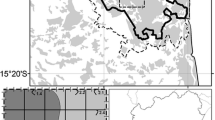Abstract
The 64 most abundant species (≥10 cm dbh) in a 400×480 m plot of predominantly kerangas forest in Sarawak were individually investigated for two-dimensional pattern by spectral analysis using the basal areas of trees in 20×20 m contiguous quadrats. All species had individuals in the upper canopy.
30 species showed pattern with clumps. The most frequent scales of clump size were between 35 and 55 m across. Patterned species were less abundant in the plot, had a greater proportion of smaller (10–20 cm dbh) trees and had a lower ratio of upper to lower canopy trees than species without pattern.
Trend across the plot between dipterocarp and kerangas forest types matched the change in soil from red-yellow podzol (oxisol and ultisol) to medium gleyic and bleached sand podzols (spodosol). However, soil differences and small scale (ca. 50 m) changes in topography did not account for patterns.
The scale of pattern matches the size of gaps produced by windthrow. It is suggested that patterned species are light-demanding and grow from seeds in gaps, whereas non-patterned species are shade tolerant, growing within closed forest to sapling size and eventually maturing by filling smaller single tree gaps.
Similar content being viewed by others
References
Ashton, P. S., 1964. Ecological studies in the mixed dipterocarp forests of Brunei State. Oxf. For. Mem. 25:.
Ashton, P. S., 1969. Speciation among tropical forest trees: some deductions in the light of recent evidence. Biol. J. Linn. Soc. 1: 155–196.
Ashton, P. S., 1977. A contribution of rain forest research to evolutionary theory. Ann. Mo. bot. Gdn. 64: 649–705.
Ashton, P. S., 1982. Dipterocarpaceae. Flora Malesiana 9: 237–552.
Austin, M. P., Ashton, P. S. & Greig-Smith, P., 1972. The application of quantitative methods to vegetation survey. III. A reexamination of rain forest data from Brunei. J. Ecol. 60: 305–324.
Brünig, E. F., 1964. A study of damage attributed to lightning in two areas of Shorea albida forest in Sarawak. Com. For. Rev. 43: 134–144.
Brünig, E. F., 1966. Der Heidewald von Sarawak und Bruneieine Studie seiner Vegetation und Ökologien. Habil. Thesis, Hamburg Univ. 136 pp.
Brünig, E. F., 1968. Der Heidewald von Sarawak und Brunei. Vol. I Site and vegetation, Vol. II Annotated species list. Mitt. BundForchAnst. Forst-u. Holzw., Hamburg 68: 1–431 pp.
Brünig, E. F., 1973a. Biomass diversity and biomass sampling in tropical rain forest. In: H. E., Young (ed.) IUFRO Biomass Studies, pp. 269–294. Coll. Life Sci. Agric.; Univ. Maine, Orono.
Brünig, E. F., 1973b. Species richness and stand diversity in relation to site and succession of forests in Sarawak and Brunei (Borneo). Amazoniana 4: 293–320.
Brünig, E. F., 1973c. Some further evidence on the amount of damage attributed to lightning and wind-throw inShorea albida forest in Sarawak. Comm. For. Rev. 52: 260–265.
Brünig, E. F., 1974. Ecological studies in the kerangas forests of Sarawak and Brunei. Borneo Lit. Bur. and Sarawak For. Dept. 237 pp.
Brünig, E. F., 1976. Classifying for mapping of kerangas and peatswamp forest as examples of primary forest types in Sarawak (Borneo). In: P. & M. Ashton (eds.) Trans. 4th. Aberdeen-Hull Symp. on Malesian Ecology., Univ. Hull, Geog. Dept., Misc. Ser. 17: 57–75.
Diggle, P. J., 1983. Statistical analysis of spatial point patterns. Academic Press, London.
Ford, E. D. & Renshaw, E., 1984. The interpretation of process from pattern using two-dimensional spectral analysis: modelling single species patterns in vegetation. Vegetatio 56: 113–123.
Greig-Smith, P., 1979. Pattern in vegetation. J. Ecol. 67: 755–779.
Greig-Smith, P., 1983. Quantitative Plant Ecology. 3rd. ed. Blackwell, Oxford.
Hill, M. O., 1979. TWINSPAN-A FORTRAN Programme for arranging multivariate data in an ordered two-way table by classification of individuals and attributes. Ecol. & Syst., Cornell Univ., Ithaca, New York.
Newbery, D. McC. & Proctor, J., 1984. Ecological studies in four contrasting lowland rain forests in Gunung Mulu National Park, Sarawak. IV. Associations between tree distributions and soil factors. J. Ecol. 72: 475–493.
Ng, F. P. S. (ed.), 1978. Tree flora of Malaya. Vol. 3. Longman, Kuala Lumpur.
Poore, M. E. D., 1968. Studies in Malaysian rain forest. I. The forest on triassic sediments in Jenka Forest Reserve. J. Ecol. 56: 143–196.
Renshaw, E. & Ford, E. D., 1983. The interpretation of process from pattern using two-dimensional spectral analysis: methods and problems of interpretation. Appl. Stat. 32: 51–63.
Renshaw, E. & Ford, E. D., 1984. The description of spatial pattern using two-dimensional spectral analysis. Vegetatio 56: 75–85.
Whitmore, T. C. (ed.), 1972. Tree flora of Malaya. Vol. 1. Longman, Kuala Lumpur.
Whitmore, T. C. (ed.), 1973. Tree flora of Malaya. Vol. 2 Longman, Kuala Lumpur.
Whitmore, T. C., 1982. On pattern and process in forests. In: E. I., Newman (ed.), The plant community as a working mechanism. Spec. Public. Ser. Br. Ecol. Soc. 1: 45–59. Blackwell, Oxford.
Whitmore, T. C., 1983. Secondary succession from seed on tropical rain forests. For. Abstr. Oxford 44: 767–779.
Whitmore, T. C., 1984. Tropical rain forests of the far East. 2nd. ed. Clarendon Press, Oxford.
Author information
Authors and Affiliations
Additional information
D. McC. N. thanks the Deutsche Akademische Austauschdienst for a scholarship and the British Council for travel funds to work at Hamburg. We are grateful to A. Weiscke for entry of the 1963 field records on the computer, T. W. Schneider for helpful discussions and T. C. Whitmore for commenting on earlier drafts.
Nomenclature for three species follows Whitmore (1972, 1973), Ng (1978) and Ashton (1982).
Rights and permissions
About this article
Cite this article
Newbery, D.M., Renshaw, E. & Brünig, E.F. Spatial pattern of trees in kerangas forest, Sarawak. Vegetatio 65, 77–89 (1986). https://doi.org/10.1007/BF00044877
Accepted:
Issue Date:
DOI: https://doi.org/10.1007/BF00044877




